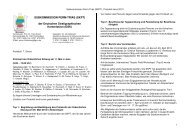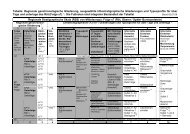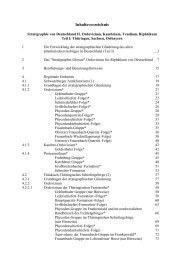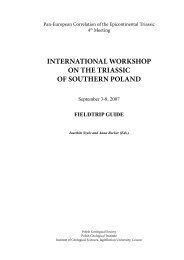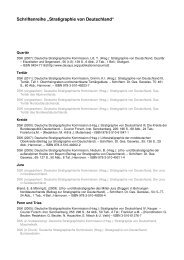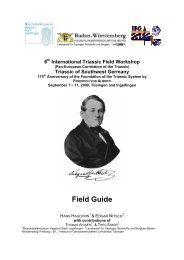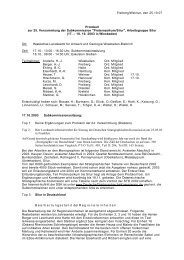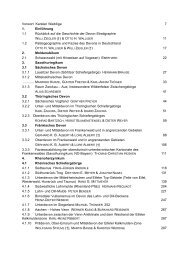International Field Workshop on 'The Triassic of eastern France'
International Field Workshop on 'The Triassic of eastern France'
International Field Workshop on 'The Triassic of eastern France'
You also want an ePaper? Increase the reach of your titles
YUMPU automatically turns print PDFs into web optimized ePapers that Google loves.
Figure II.4: A) Geometries and lithology <strong>of</strong> the Lower <strong>Triassic</strong> stratigraphic cycles, al<strong>on</strong>g the transect between<br />
the area south <strong>of</strong> Orléans (Bertray well) and the Rhine Basin (Soultz-sous-Forêts well) deduced from welllog<br />
analysis: (1) Geometries from Variscan basement or pre-<strong>Triassic</strong> deposits to the Hardegsen<br />
unc<strong>on</strong>formity (Fig. 3), (2) Geometries from the Hardegsen unc<strong>on</strong>formity to the basal anhydrite bed <strong>of</strong> the<br />
“Couches grises” Formati<strong>on</strong> defined in the <strong>eastern</strong> part <strong>of</strong> the Paris Basin (middle part <strong>of</strong> the Middle<br />
Muschelkalk, Fig. 3). (B) Transect locati<strong>on</strong>. See figure II.1B for more details. After Bourquin et al., 2006.<br />
II.2.1. - Middle Buntsandstein cycles<br />
The Middle Buntsandstein formati<strong>on</strong>s (‘C<strong>on</strong>glomérat basal’, ‘Grès vosgiens’ and ‘C<strong>on</strong>glomérat<br />
principal’) exhibit <strong>on</strong>e major cycle divided into four minor cycles (noted B1 to B4, Figs. II.1C).<br />
The correlati<strong>on</strong>s reveal the <strong>on</strong>lap <strong>of</strong> the <strong>Triassic</strong> sedimentati<strong>on</strong> <strong>on</strong>to the basement (Figs. II.3 and II.4).<br />
The bed-load fluvial sediments, attributed to braided rivers, came from the west: present-day Armorican<br />
Massif (Durand, 1978; Durand et al., 1994) and progressively filled in the topographic depressi<strong>on</strong>.<br />
Floodplain deposits are rare and characterized by clay layers a few centimetres thick. The c<strong>on</strong>glomerate<br />
deposits are mainly located in the western part <strong>of</strong> the sedimentati<strong>on</strong> area. The four minor stratigraphic cycles<br />
(B1 to B4) can be correlated across the Paris Basin up to the Rhine Graben in the east, showing that the<br />
‘C<strong>on</strong>glomérat basal’ Formati<strong>on</strong> is diachr<strong>on</strong>ous.<br />
The B1, cycle corresp<strong>on</strong>ds, in the Vosges Massif outcrops and Emberménil well, to the deposits <strong>of</strong> the<br />
‘C<strong>on</strong>glomérat basal’ Formati<strong>on</strong> (Figs. II.3 and II.4). This cycle is characterized by the vertical passage <strong>of</strong><br />
well-preserved fluvial c<strong>on</strong>glomerates into floodplain deposits. In more distal parts <strong>of</strong> the basin, the<br />
c<strong>on</strong>glomerates grade eastwards into sandst<strong>on</strong>es.<br />
The B2 and B3 cycles (Figs. II.3 and II.4), are intra – ‘Grès vosgiens’ Formati<strong>on</strong>, and record well-<br />
preserved fluvial sandst<strong>on</strong>es to floodplain deposits, the basal c<strong>on</strong>glomerate facies being located in the<br />
westernmost area. From cycles B1 to B3, we observe a general backstepping <strong>of</strong> c<strong>on</strong>glomerate facies.<br />
The isopach maps drawn up for each cycle (Figs. II.5 and II.6A) indicate the basement-sedimentati<strong>on</strong><br />
area boundary, as well as the locati<strong>on</strong> <strong>of</strong> c<strong>on</strong>glomerate facies through time and space. The more proximal<br />
15



